Common Misconceptions About Surge Protective Devices Part One: Nominal Discharge Current Ratings
Key Takeaways
- Nominal Discharge Current Rating (In) tests are not based on normal operating conditions.
- In ratings are not indicative of surge protective device (SPD) safety nor robustness.
- The vast majority of SPD failures occur due to temporary overvoltage (TOV) conditions, which the In test does not address.
To pass the In test, manufacturers must coordinate disconnect mechanisms to a degree that could preclude safe disconnection when subject to multi-pulse flashes and TOV events.
Introduction
ANSI/UL 1449 represents a widely recognized standard delineating requirements for Surge Protective Devices (SPDs) deployed in electrical applications. This benchmark standard plays a significant role in the testing and certification of SPDs. Nonetheless, there exists an imperative need to revise the existing standard to better align with an expanding knowledge base of the surge environment and evolving technologies.
For public safety, it is imperative to conduct a diligent assessment of misconceptions that exist in the current zeitgeist of surge protective devices.
Misconception One: Nominal Discharge Current Rating tests are based on normal operating conditions
In the context of ANSI/UL 1449, the term “Nominal Discharge Current Rating” often causes confusion due to many people misinterpreting the term ‘nominal’ to mean ‘normal’. While the two words have distinct meanings, they are often mistaken for one another due to their close phonetic resemblance, leading to misunderstandings in technical discussions and product evaluations. Adding to this confusion is the fact that both words are commonly used in the field of electrical engineering including within ANSI/UL 1449 itself. This confusion leads some to believe the test waveforms utilized in the “Nominal Discharge Current Rating” test are normal or common when in fact they are abnormal and uncommon.
The term ‘nominal’ in “Nominal Discharge Current Rating” actually means ‘designated’ or ‘specified’.
The term ‘normal’ in the context of electrical engineering and standards refers to a system or device’s expected or typical operational state. It is used to describe regular operating conditions without the presence of abnormal or exceptional events, such as surges or faults. The “Nominal Discharge Current Rating” assessment, denoted as In, subjects an SPD to abnormal events.
Misconception Two: SPDs with higher Nominal Discharge Current Ratings are more robust, therefore these ratings are indicative of SPD safety
A cursory examination of comments [12] made by representatives of SPD manufacturers on this matter during the Technical Meeting of the 2023 NFPA 70 NEC held in June 2022 reveals the widespread prevalence of this fallacy and its propagation.
- “The testing (In) also shows the product reliability, and continued performance after being subjected to surge events.”
- “The nominal discharge current demonstrates the product reliability and longevity.”
- “This requirement increases the longevity of these protection devices…”
- “These (In rating) are here for safety.”
- “It’s (In rating) transparency for what you’re getting.”
The parties accountable for formulating these statements have neglected to consider the failure mechanisms of Metal Oxide Varistor (MOV) type SPDs triggered by temporary overvoltage (TOV) and/or multiple-pulse lightning flashes as well as numerous other causes of SPD failure.
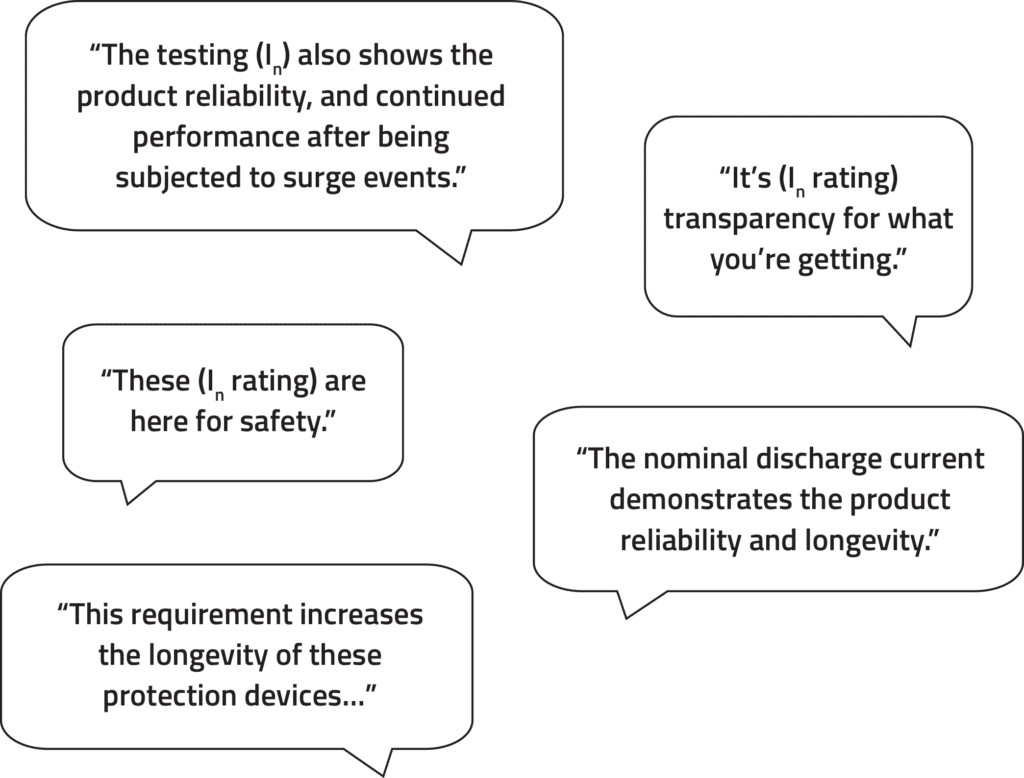
Multi-Pulse Lightning Flashes
As per the findings of CIGRE, ≈ 90% of global cloud-to-ground lightning is comprised of downward negative flashes. [1] The organization further states ≈ 80% of negative flashes manifest as multi-pulse events, [1] implying the preponderance of lightning flashes encountered by SPDs in practical settings involve multiple pulses, rather than solitary ones. [5], [6], [7], [8], [13], [19] In addition, long continuing currents are present in roughly 30-50% of all negative cloud-to-ground flashes creating another issue of significant apprehension for MOV-type SPDs. [1], [3], [5]
A plethora of papers have been published examining the behavior of MOV-type utility distribution surge arresters under the influence of multi-pulse lightning flashes. [13], [14], [15], [16], [17] When exposed to multi-pulse flashes, the collective research indicates 10 kA In rated utility arresters have a higher probability of preventing undesirable failures that could potentially endanger safety than their 5 kA In counterparts. [5], [13], [15], [16]
Consequently, some assume this “higher is better” principle applies to low-voltage SPDs equipped with much smaller MOVs. [12] However, it should be noted this assumption does not invariably hold true.
A considerable number of papers have highlighted ANSI/UL 1449 Listed SPDs, some bearing the highest In rating available, have demonstrated unsafe failure [6], [7], [8], [9], [10], [19] in laboratory and field tests when exposed to multi-pulse flashes. MOVs are readily damaged by multi-pulse currents of magnitudes below their single-impulse current ratings. [10], [18] The measured currents related to these failures have been documented as low as 1.64 kA [19] and 1.67 kA. [10] The authors of these studies have characterized the SPD failures as “shattering-induced destruction”, “catch fire”, [19] “obvious burns”, [10] “evident burns”, and “destructive temperature rise”. The research further suggests MOV-type SPDs are prone to damage from currents as low as 35% of their In rating when subjected to multi-pulse flashes. [18]
Unlike MOV-type surge arresters utilized in utility distribution, the information gathered infers a low-voltage, MOV-type SPD’s robustness cannot be correlated to the device’s In rating. Rather, it appears the existing In test could inadvertently be permitting hazardous SPDs to enter the market. In order to pass the ANSI/UL 1449 In rating test, manufacturers are required to coordinate their disconnect mechanisms to a degree that can preclude safe disconnection when confronted with multi-pulse events. Since the ANSI/UL 1449 In test forbids SPDs from disconnecting, some manufacturers use a disconnect method that has shown to be incapable of responding appropriately to multi-pulse flashes. [6], [7], [8], [9], [10], [19]
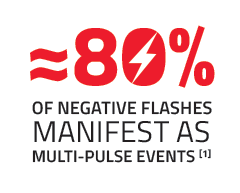
![Figure 7 Failure modes of ZnO varistor under multi-pulse applied load. [19]](https://maxivolt.com/wp-content/uploads/2024/01/Fig-7-source-19-768x594.png)
![(a) Before impact damage, (b) after impact damage and explosion Figure 5 Surface temperature rise distribution of ZnO varistor. [19]](https://maxivolt.com/wp-content/uploads/2024/01/Thermal-imaging-damage-1024x421.png)
Temporary Overvoltage
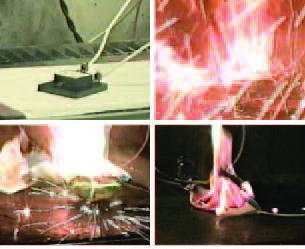
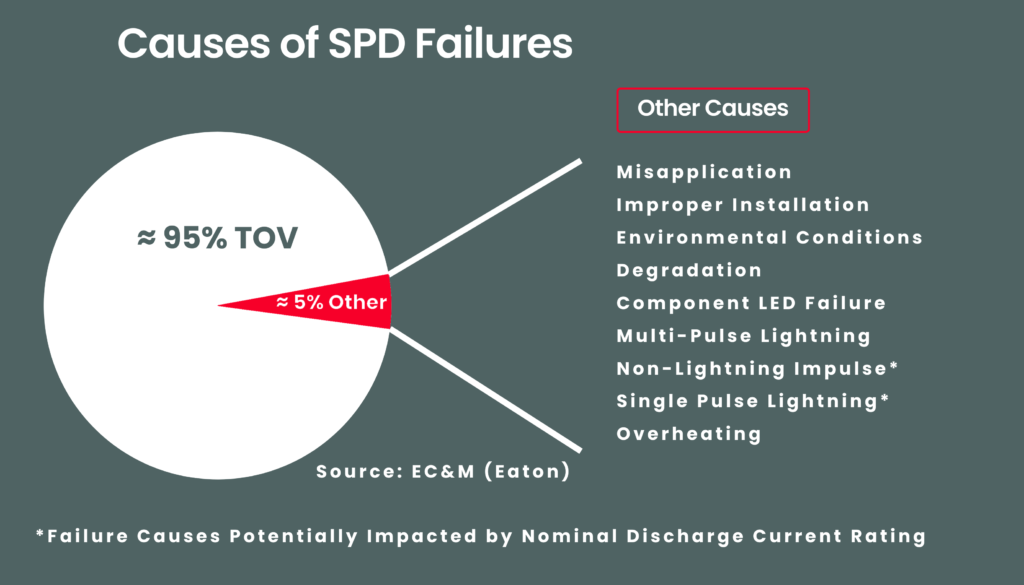
It is well documented a protracted TOV can cause a MOV to enter into a thermal runaway and fail catastrophically. [22]
Due to the wide variability of TOV events in both time duration and voltage, it is helpful to create categories of TOV events for discussion purposes. Mandoor and Martzloff introduced useful categories in their IEEE paper titled, The Dilemma of Surge Protection vs. Overvoltage Scenarios. [20]
They are as follows:
Moderate TOVs associated with power system faults, such as a line-to-earth fault in a three-phase system, creating a 1.73 times normal line voltage in the other phases.
Double voltage TOVs associated with the loss of neutral in a single-phase, three-conductor, earthed center tap system such as the 120/240 V service typical of North American systems.
Extreme TOVs associated with the commingling scenario (accidental fall of conductors of a higher voltage upon conductors of a lesser voltage). No conventional, varistor-only SPD can be expected to survive such a scenario.
A review of the existing UL 1449 testing protocols shows a blindspot in testing the safe disconnection for “Extreme” TOV categories. With the number of severe weather events expected to increase [21] that are known to cause “Extreme” TOV events, coupled with the rapid adoption of SPD requirements in the NEC, SPDs will be interacting with more TOV events in the field. Due to the lack of appropriate TOV testing in UL1449 for “Extreme” TOV, designers of SPDs may possibly omit consideration for TOV failure modes from their designs. [20], [22], [26]
Once again, it appears the existing In test is inadvertently allowing hazardous SPDs to enter the market, similar to the case with multi-pulse events. SPD designers must coordinate their disconnect mechanisms to pass the ANSI/UL 1449 In test, which can hinder safe disconnection when faced with “extreme” TOV events.
Conclusion
It is self-evident that In tests are not based on normal operating conditions, as the vast majority of SPD failures occur due to temporary overvoltage (TOV) conditions and multi-pulse lightning flashes, which these tests do not address. The data presented on SPD interactions with both TOV and multi-pulse events conclusively demonstrates relying on the In rating as a measure of robustness for low-voltage SPDs is an erroneous approach and should be abandoned.
Moreover, to pass the In test, manufacturers must coordinate disconnect mechanisms to a degree that could preclude safe disconnection when subject to TOV events and multi-pulse lightning flashes. The existing version of ANSI/UL 1449 appears to have a safety oversight since its testing protocol fails to consider the unacceptable failure conditions resulting from the most frequently occurring form of lightning flashes as well as commonly occurring TOV events.
Resources
[1] Working Group C4.407, “Lightning Parameters for Engineering Applications”, CIGRE, August 2013
[2] W. Brooks, D. Barnett, W.A. Harrison, D. Hattz, J. Mankowski, J. Dickens, A. Neuber, “Investigation of Lightning Attachment Risks to Small Structures Associated With the Electrogeometric Model (EGM)”, IEEE Transactions on Plasma Science, Vol. 48, No. 6, June 2020
[3] A. Martin, “Effect of Multi-burst Lightning Flashes on Surge Protective Devices Using MOVs”, www.incompliancemag.com, October 31, 2017”
[4] A. Martin, “How and Why Varistor Failure Occures Including the Effect of Multipulse Surges”, www.incompliancemag.com, August 31, 2020
[5] C. Heinrich, S. Wagner, B. Richter, W. Kalkner, “Multiple Tests on Surge Arresters for Medium and Low Voltage Systems”, 1998 International Conference on Lightning Protection (ICLP), 1998
[6] R. A. Sargent, G. L. Dunlop, M. Darveniza, “Effects of Multiple Impulse Currents on the Microstructure and Electrical Properties of Metal-oxide Varistors”, IEEE Transactions on Electrical Insulation, Vol. 27, No. 3, June 1992
[7] C. Zhang, X. Yi, C. Li, G. Zhang, M. Kong, “Study on Lightning Thermal Damage Characteristics of ZnO Varistor under Operating Duty”, 2022 IEEE Asia-Pacific Conference on Image Processing, Electronics and Computers (IPEC), 2022
[8] C. Zhang, H. Xing, P. Li, C. Li, D. Lv, S. Yang, “An Experimental Study of the Failure Mode of ZnO Varistors Under Multiple Lightning Strokes”, Electronics Journal, MDPI, 2019
[9] A. Rousseau, X. Zang, M. Tao, “Multiple Shots on SPDs – additional tests”, 2014 International Conference on Lightning Protection (ICLP), 2014
[10] S. Yang, S. Chen, Y. Zhang, W. Dong, J. Wang, M. Zhou, D. Zheng, H. Yu, “Triggered Lightning Analysis Gives New Insight into Over Current Effects on Surge Protective Devices”, Guangdong Lightning Protection Center, 2011
[11] M. Edirisinghe, R. Montano, V. Cooray, F. Roman, “Performance comparison of varistor models under high current derivative impulses”, International Letters of Chemistry, Physics and Astronomy, ISSN: 2299-3843, Vol. 11, pp 40-53, 2013
[12] NFPA, “Transcript – Day 2”, NFPA NEC 70 Technical Session, June 9, 2022
[13] M. Darveniza, B. Richter, D.A. Roby, “Multipulse Lightning Currents and Metal-Oxide Arresters”, IEEE Transactions on Power Delivery, Vol. 12, No.3, July 1997
[14] B. Vahidi, K. J. Cornick, D. A. Greaves, “Effects of Multiple Stroke on ZnO Surge Arresters”, 1998 International Conference on Lightning Protection (ICLP), 1998
[15] M. Darveniza, D. R. Mercer, L. R. Tumma, “Effects of Multiple Stroke Lightning Impulse Currents on ZnO Arresters”, University of Queensland, Australia
[16] M. Darveniza, D. Roby, L. R. Tumma, “Laboratory and Analytical Studies of the Effects of Multipulse Lightning Current on Metal Oxide Arresters”, IEEE Transactions on Power Delivery, Vol. 9, No. 2, April 1994
[17] M. Darveniza, D. R. Mercer, “Laboratory Studies of The Effects of Multipulse Lightning Currents on Distribution Surge Arresters”, IEEE Transactions on Power Delivery, Vol. 8, No. 3, July 1993
[18] M. Darveniza, “Failure Modes of Surge Protective Devices”, Department of Electrical and Computer Engineering, The University of Queensland, Australia
[19] C. Li, C. Zhang, G. Zhang, M. Kong, Z. Yang, “Analysis of the failure mode of surge protector under multi-pulse lightning strikes and its mechanism”, The 5th International Conference on Electrical Engineering and Green Energy (CEEGE), Berlin, June 2022
[20] A. Mansoor, F. Martzloff, “The Dilemma of Surge Protection vs. Overvoltage Scenarios: Implications for Low-Voltage Surge-Protective Devices”, IEEE 8th Annual Conference on Harmonics and Quality of Power, Athens, October 1998
[21] USGCRP, 2018: Impacts, Risks, and Adaptation in the United States: Fourth National Climate Assessment, Volume II: [Reidmiller, D.R., C.W. Avery, D.R. Easterling, K.E. Kunkel, K.L.M. Lewis, T.K. Maycock, and B.C. Stewart (eds.)]. U.S. Global Change Research Program, Washington, DC, USA, 1515 pp. doi: 10.7930/NCA4.2018
[22] EPRI Power Quality Knowledge Program, “Protecting Against Surges and Temporary Overvoltage”, PQ TechWatch, Electric Power Research Institute (EPRI), August 2011
[23] Working Group C4.407, “TB549 Lightning Parameters for Engineering Applications”, CIGRE, 2013 [24] IEC 62305-1, “Protection against lightning – Part 1: General principles”, Edition 2.0, 2010-12
[25] Electric Power Research Institute (EPRI) “Characteristics of Lightning Surges on Distribution Lines, Second Phase – Final Report”, Research Project 2542-1, December 1991
[26] K. Eilers, M. Wingate, E. Pham, “Application and Safety Issues for Transient Voltage Surge Suppressors”, IEEE Transactions on Industry Applications, Vol. 36, No. 6, November/December 2000
[27] W. Brooks, M. LaPointe, L. Collier, J. Mankowski, J. Dickens, D. Hattz, N. Koone, A. Neuber, “Lightning Current Propagation in Electrical Conduit”, IEEE Transactions on Plasma Science, Vol. 50, Issue 1, January 2022
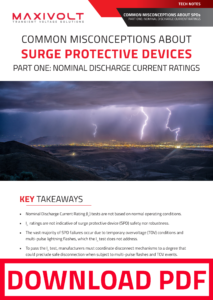
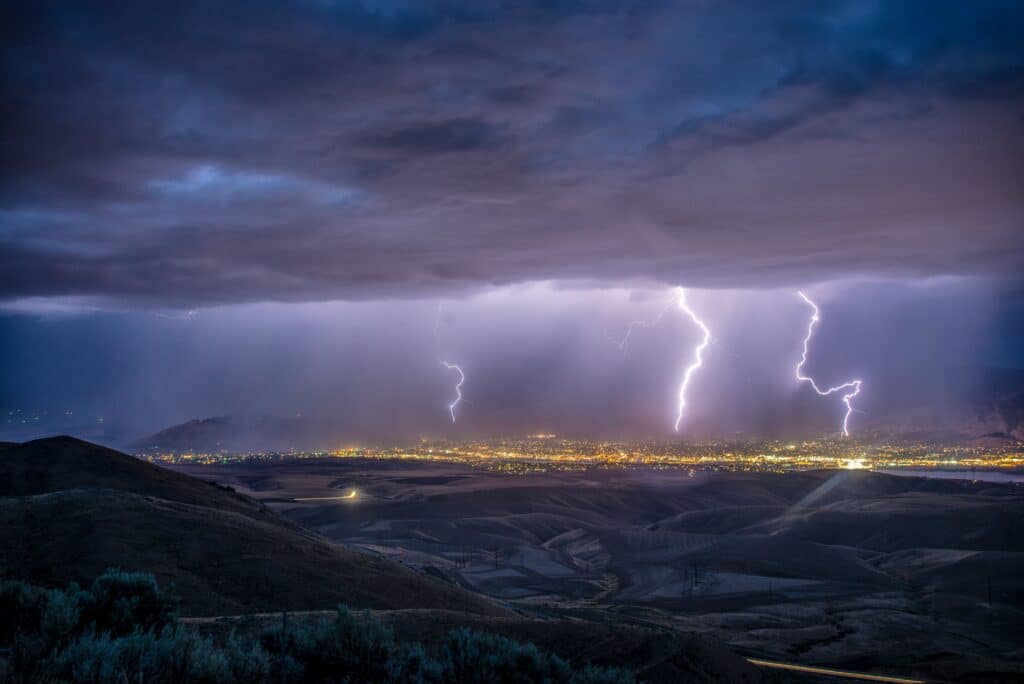



One Response